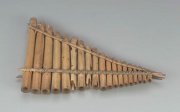Difference between revisions of "Reed"
Jump to navigation
Jump to search
(username removed) |
|||
| (9 intermediate revisions by 3 users not shown) | |||
| Line 1: | Line 1: | ||
| − | [[File:17.1842-SC29759.jpg|thumb|]] | + | [[File:17.1842-SC29759.jpg|thumb|Panpipes<br>MFA# 17.1842]] |
== Description == | == Description == | ||
| − | The common name for any of several tall [ | + | The common name for any of several tall [[grass|grasses]], especially of the genera ''Phragmites'' or ''Arundo''. The common reed, ''Phragmites communis'', is native to marshes and wetlands in Europe, Asia and the Middle East. Reed stalks have hollow, circular stems composed of soft bulky fibers. Small thin pieces of the stems have been used to make musical wind instruments. Fibers from the stalks are used for making baskets and [[paper%20pulp|paper pulp]]. The paper reed, ''Cyperus papyrus'', used for ancient Egyptian [[papyrus|papyrus]], is actually a sedge type grass with a triangular stem. Writing instruments, or [[Pen]]s, made from hollow reeds have been found in Ancient Egyptian sites dating from the 4th century BC. |
| − | + | [[File:MFA02680 reed basket.jpg|thumb|Reed basket<br>MFA# 02.680]] | |
== Synonyms and Related Terms == | == Synonyms and Related Terms == | ||
common reed; ditch reed; grass; carrizo (Esp.) | common reed; ditch reed; grass; carrizo (Esp.) | ||
| − | == | + | == Resources and Citations == |
| − | |||
| − | |||
| − | |||
| − | |||
| − | |||
| − | |||
| + | * Matt Roberts, Don Etherington, ''Bookbinding and the Conservation of Books: a Dictionary of Descriptive Terminology'', U.S. Government Printing Office, Washington DC, 1982 | ||
| + | * Random House, ''Webster's Encyclopedic Unabridged Dictionary of the English Language'', Grammercy Book, New York, 1997 | ||
| + | * A.Lucas, J.R.Harris, ''Ancient Egyptian Materials and Industries'', Edward Arnold Publishers Ltd., London, 4th edition, 1962 | ||
* ''The American Heritage Dictionary'' or ''Encarta'', via Microsoft Bookshelf 98, Microsoft Corp., 1998 | * ''The American Heritage Dictionary'' or ''Encarta'', via Microsoft Bookshelf 98, Microsoft Corp., 1998 | ||
| − | + | * Wikipedia: [https://en.wikipedia.org/wiki/Reed_pen Reed pen] Accessed March 2025 | |
[[Category:Materials database]] | [[Category:Materials database]] | ||
Latest revision as of 16:03, 25 March 2025
Description
The common name for any of several tall grasses, especially of the genera Phragmites or Arundo. The common reed, Phragmites communis, is native to marshes and wetlands in Europe, Asia and the Middle East. Reed stalks have hollow, circular stems composed of soft bulky fibers. Small thin pieces of the stems have been used to make musical wind instruments. Fibers from the stalks are used for making baskets and Paper pulp. The paper reed, Cyperus papyrus, used for ancient Egyptian Papyrus, is actually a sedge type grass with a triangular stem. Writing instruments, or Pens, made from hollow reeds have been found in Ancient Egyptian sites dating from the 4th century BC.
Synonyms and Related Terms
common reed; ditch reed; grass; carrizo (Esp.)
Resources and Citations
- Matt Roberts, Don Etherington, Bookbinding and the Conservation of Books: a Dictionary of Descriptive Terminology, U.S. Government Printing Office, Washington DC, 1982
- Random House, Webster's Encyclopedic Unabridged Dictionary of the English Language, Grammercy Book, New York, 1997
- A.Lucas, J.R.Harris, Ancient Egyptian Materials and Industries, Edward Arnold Publishers Ltd., London, 4th edition, 1962
- The American Heritage Dictionary or Encarta, via Microsoft Bookshelf 98, Microsoft Corp., 1998
- Wikipedia: Reed pen Accessed March 2025

